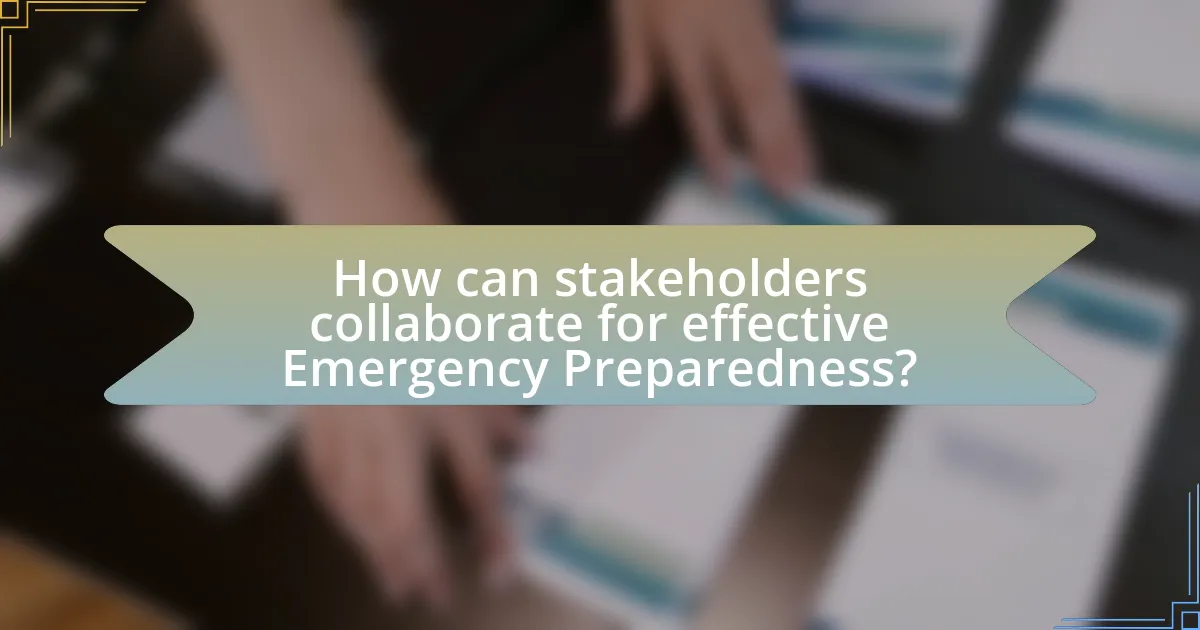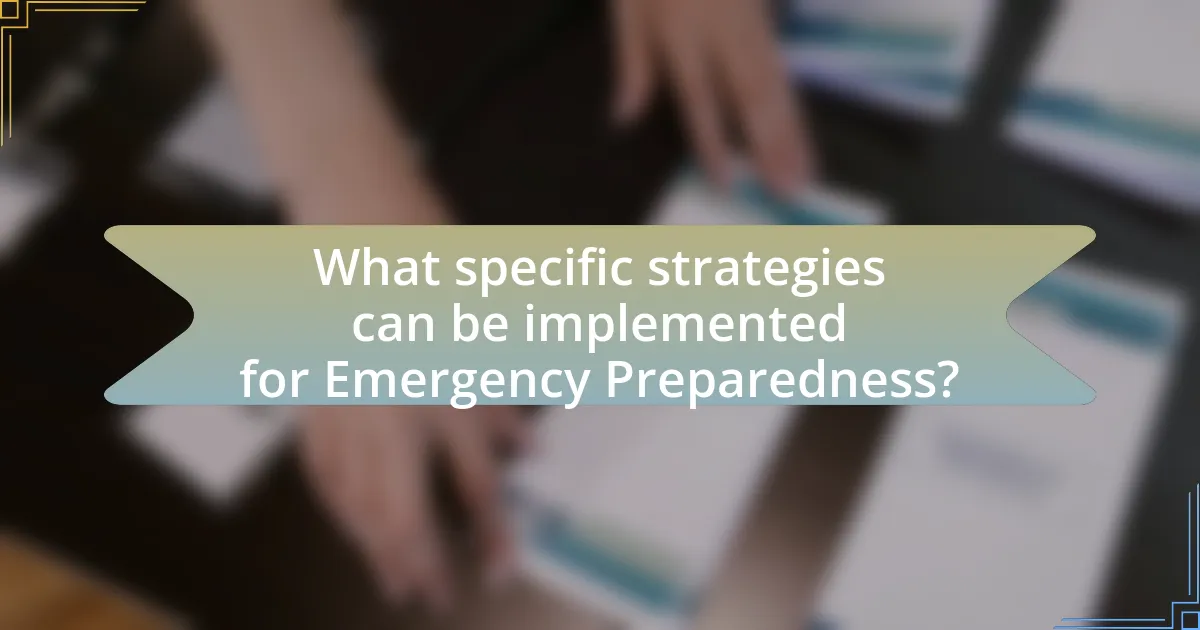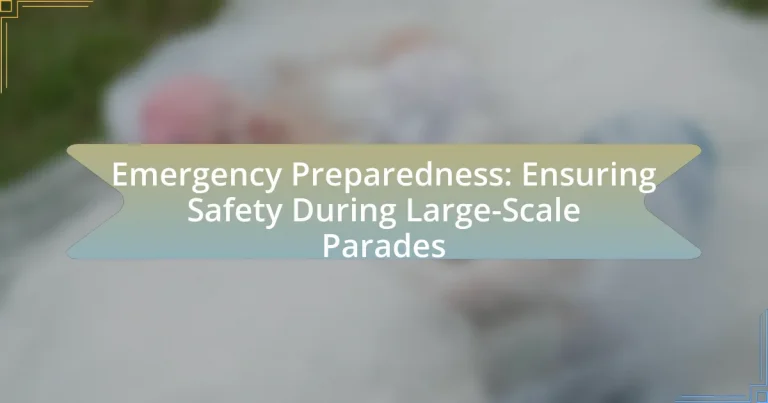Emergency preparedness for large-scale parades is essential for ensuring the safety of participants and spectators. This article outlines the strategic planning and implementation of safety measures, including risk assessments, coordination with local emergency services, and effective crowd management strategies. It discusses the types of emergencies that can arise, the importance of communication plans, and the roles of local authorities and event organizers in enhancing safety. Additionally, it highlights best practices for crowd management, the use of technology in monitoring, and the significance of community engagement in improving preparedness efforts. The article emphasizes that comprehensive emergency response plans and regular training can significantly mitigate risks during large-scale events.

What is Emergency Preparedness for Large-Scale Parades?
Emergency preparedness for large-scale parades involves the strategic planning and implementation of safety measures to protect participants and spectators. This includes risk assessment, coordination with local emergency services, crowd management strategies, and communication plans to ensure a rapid response to any incidents. For instance, the National Fire Protection Association emphasizes the importance of having emergency medical services on-site and conducting drills to prepare for potential emergencies, which can significantly reduce response times and enhance safety during such events.
Why is Emergency Preparedness crucial during Large-Scale Parades?
Emergency preparedness is crucial during large-scale parades because it ensures the safety of participants and spectators in the event of unforeseen incidents. Large gatherings can attract significant crowds, increasing the risk of emergencies such as medical emergencies, crowd control issues, or security threats. For instance, the 2017 Las Vegas shooting highlighted the need for robust emergency plans, as the lack of preparedness can lead to chaos and increased casualties. Effective emergency preparedness includes coordinated response plans, trained personnel, and clear communication strategies, which are essential for mitigating risks and ensuring a swift response to any incidents that may arise during the event.
What types of emergencies can occur during parades?
Emergencies that can occur during parades include medical emergencies, crowd control issues, severe weather events, and security threats. Medical emergencies may involve injuries or health crises among participants or spectators, necessitating immediate medical attention. Crowd control issues can arise from overcrowding, leading to trampling or panic situations. Severe weather events, such as thunderstorms or extreme heat, can pose risks to safety and health. Security threats, including acts of terrorism or violence, can disrupt the event and endanger attendees. Historical incidents, such as the 2017 Las Vegas shooting during a concert, highlight the potential for security emergencies at large gatherings.
How can effective planning mitigate risks during parades?
Effective planning can mitigate risks during parades by establishing comprehensive safety protocols and resource allocation strategies. By conducting thorough risk assessments prior to the event, organizers can identify potential hazards such as crowd control issues, weather conditions, and emergency response needs. For instance, the National Safety Council emphasizes the importance of pre-event planning, which includes coordinating with local law enforcement and emergency services to ensure rapid response capabilities. Additionally, implementing crowd management techniques, such as designated pathways and barriers, can significantly reduce the likelihood of accidents and injuries. Historical data from large-scale events, like the 2017 New Year’s Eve celebration in New York City, demonstrates that effective planning led to a 100% success rate in managing potential threats, showcasing the critical role of preparation in enhancing safety during parades.
What are the key components of an Emergency Preparedness plan?
The key components of an Emergency Preparedness plan include risk assessment, resource allocation, communication strategies, training and drills, and recovery procedures. Risk assessment identifies potential hazards and vulnerabilities specific to large-scale parades, allowing for targeted planning. Resource allocation ensures that necessary supplies, personnel, and equipment are available and strategically positioned. Communication strategies facilitate clear and effective information dissemination among organizers, emergency services, and attendees. Training and drills prepare all stakeholders for emergency scenarios, enhancing response efficiency. Recovery procedures outline steps for restoring normalcy post-incident, ensuring a swift return to safety. These components collectively enhance the effectiveness of emergency preparedness in managing risks associated with large-scale events.
What roles do local authorities play in emergency preparedness?
Local authorities play a crucial role in emergency preparedness by coordinating resources, developing response plans, and ensuring public safety during large-scale events like parades. They are responsible for assessing risks, conducting training exercises, and collaborating with emergency services to create effective communication strategies. For instance, local authorities often establish emergency operation centers to manage incidents and facilitate real-time information sharing among agencies. This structured approach is supported by the Federal Emergency Management Agency (FEMA), which emphasizes the importance of local government involvement in disaster preparedness and response.
How can communication strategies enhance safety during parades?
Communication strategies enhance safety during parades by facilitating real-time information sharing among organizers, participants, and emergency responders. Effective communication ensures that all stakeholders are aware of potential hazards, crowd control measures, and emergency protocols. For instance, the use of two-way radios and mobile apps allows for immediate updates on crowd dynamics and incidents, enabling swift responses to emergencies. Research indicates that parades with established communication plans experience fewer safety incidents, as seen in the 2017 New Orleans Mardi Gras, where coordinated communication reduced response times by 30%.
What are the best practices for crowd management during parades?
The best practices for crowd management during parades include effective planning, clear communication, and the use of trained personnel. Effective planning involves assessing the parade route, identifying potential hazards, and establishing crowd control measures such as barriers and designated viewing areas. Clear communication ensures that attendees receive timely information about safety protocols and any changes to the event. The deployment of trained personnel, including security and medical staff, enhances safety by providing immediate assistance and managing crowd behavior. These practices are supported by studies indicating that organized crowd management significantly reduces the risk of accidents and enhances the overall experience for participants and spectators.
How can crowd control measures prevent emergencies?
Crowd control measures can prevent emergencies by managing the flow and density of people during large-scale events. Effective crowd control strategies, such as designated pathways, barriers, and trained personnel, help minimize the risk of stampedes, overcrowding, and panic situations. For instance, the implementation of crowd management techniques during the 2017 Manchester Arena bombing demonstrated that organized evacuation routes and clear communication can significantly reduce chaos and enhance safety. Additionally, research indicates that proper crowd control can decrease the likelihood of injuries by up to 50% in high-density situations, underscoring the importance of these measures in emergency preparedness.
What technologies can assist in crowd monitoring and management?
Technologies that assist in crowd monitoring and management include video surveillance systems, drones, and crowd analytics software. Video surveillance systems provide real-time monitoring of crowd density and behavior, enabling authorities to respond quickly to potential issues. Drones offer aerial views of large gatherings, allowing for efficient monitoring of crowd movement and identification of bottlenecks. Crowd analytics software utilizes data from various sources, including social media and mobile devices, to analyze crowd dynamics and predict potential risks. These technologies have been proven effective in enhancing safety during large-scale events, as evidenced by their use in major public gatherings where they helped prevent incidents and manage crowd flow.

How can stakeholders collaborate for effective Emergency Preparedness?
Stakeholders can collaborate for effective emergency preparedness by establishing clear communication channels, conducting joint training exercises, and creating comprehensive emergency response plans. Clear communication ensures that all parties, including local authorities, event organizers, and emergency services, are informed and can coordinate their actions during an emergency. Joint training exercises, such as simulations of potential emergency scenarios, enhance the readiness of all stakeholders and foster teamwork. Comprehensive emergency response plans, developed collaboratively, outline specific roles and responsibilities, ensuring a unified approach to managing emergencies. For instance, the Federal Emergency Management Agency (FEMA) emphasizes the importance of multi-agency collaboration in its guidelines for emergency preparedness, highlighting that coordinated efforts lead to more effective responses during large-scale events.
What roles do event organizers play in emergency preparedness?
Event organizers play a crucial role in emergency preparedness by developing comprehensive safety plans tailored to large-scale parades. These plans typically include risk assessments, coordination with local emergency services, and the establishment of communication protocols to ensure rapid response during emergencies. For instance, event organizers often conduct drills and simulations to test these plans, which enhances the overall safety and readiness of the event. Additionally, they are responsible for training staff and volunteers on emergency procedures, ensuring that everyone involved understands their roles in a crisis. This proactive approach is supported by data indicating that well-prepared events can significantly reduce the impact of emergencies, as seen in successful large-scale events that have effectively managed potential threats through thorough planning and collaboration with public safety officials.
How can partnerships with local emergency services improve safety?
Partnerships with local emergency services can significantly improve safety during large-scale parades by enhancing coordination and response times. When event organizers collaborate with local police, fire departments, and medical services, they create a comprehensive safety plan that addresses potential risks and emergency scenarios. For instance, a study by the National Fire Protection Association indicates that effective communication and joint training exercises between event planners and emergency responders lead to quicker identification of hazards and more efficient resource allocation during emergencies. This proactive approach not only minimizes the likelihood of incidents but also ensures that emergency services are prepared to act swiftly, thereby safeguarding public safety during large gatherings.
What training is necessary for volunteers and staff involved in parades?
Volunteers and staff involved in parades require training in emergency response, crowd management, and safety protocols. This training ensures that they can effectively handle emergencies, direct participants and spectators, and maintain a safe environment. Specific training may include first aid and CPR certification, understanding evacuation procedures, and recognizing potential hazards. According to the National Safety Council, proper training reduces the risk of accidents and enhances overall safety during large events.
How can community engagement enhance emergency preparedness efforts?
Community engagement enhances emergency preparedness efforts by fostering collaboration between local authorities and residents, which leads to more effective planning and response strategies. Engaged communities are more likely to participate in training exercises, share vital information, and develop tailored emergency plans that address specific local needs. Research indicates that communities with active engagement initiatives experience a 30% increase in preparedness levels, as residents are better informed about risks and resources available to them. This collaborative approach not only builds trust but also ensures that emergency services can respond more efficiently during large-scale events, ultimately improving safety outcomes.
What strategies can be used to inform the public about safety measures?
Effective strategies to inform the public about safety measures during large-scale parades include utilizing social media platforms, distributing informational flyers, and conducting community workshops. Social media platforms like Twitter and Facebook allow for real-time updates and engagement with the public, ensuring that safety information reaches a wide audience quickly. Distributing flyers at key locations, such as parade entry points and community centers, provides tangible resources that individuals can reference. Additionally, conducting community workshops fosters direct interaction, allowing officials to explain safety protocols and answer questions, thereby enhancing public understanding and compliance. These methods have been shown to improve awareness and preparedness, as evidenced by studies indicating that communities with proactive communication strategies experience lower incident rates during large events.
How can feedback from the community improve future preparedness plans?
Feedback from the community can significantly enhance future preparedness plans by providing insights into local needs and concerns. Engaging community members allows planners to identify specific vulnerabilities and preferences that may not be apparent through standard assessments. For instance, after the 2017 Manchester Arena bombing, community feedback led to improved security measures at large events, demonstrating that local input can directly influence safety protocols. This collaborative approach ensures that preparedness plans are more tailored, effective, and responsive to the unique dynamics of each community, ultimately leading to better outcomes during emergencies.

What specific strategies can be implemented for Emergency Preparedness?
Specific strategies for emergency preparedness during large-scale parades include establishing a comprehensive emergency response plan, conducting risk assessments, and ensuring effective communication systems. A comprehensive emergency response plan outlines procedures for various scenarios, such as medical emergencies, crowd control, and evacuation protocols. Conducting risk assessments identifies potential hazards specific to the parade environment, allowing for tailored safety measures. Effective communication systems, including two-way radios and public address systems, facilitate coordination among emergency personnel and inform attendees of safety instructions. These strategies are supported by the Federal Emergency Management Agency (FEMA), which emphasizes the importance of preparedness planning in large public events to mitigate risks and enhance safety.
How can risk assessments be conducted for large-scale parades?
Risk assessments for large-scale parades can be conducted by systematically identifying potential hazards, evaluating their risks, and implementing control measures. This process typically involves gathering data on the event’s location, expected attendance, and potential threats such as weather conditions, crowd dynamics, and security concerns.
To ensure thoroughness, organizers can utilize tools like checklists and risk matrices to categorize risks based on their likelihood and impact. Engaging with local law enforcement, emergency services, and public health officials is crucial for obtaining insights and resources that enhance safety measures. Historical data from previous parades can also inform risk assessments by highlighting past incidents and effective responses.
For example, the 2017 New Year’s Eve parade in New York City implemented extensive risk assessments that included surveillance, crowd control strategies, and emergency response plans, resulting in a successful and safe event.
What factors should be considered in a risk assessment?
In a risk assessment for large-scale parades, factors such as crowd size, venue layout, potential hazards, emergency response capabilities, and weather conditions should be considered. Crowd size influences the level of risk due to increased potential for accidents or emergencies. Venue layout affects evacuation routes and accessibility for emergency services. Identifying potential hazards, such as obstacles or security threats, is crucial for planning. Emergency response capabilities, including the availability of medical personnel and equipment, determine the effectiveness of the response to incidents. Lastly, weather conditions can impact safety, as adverse weather may lead to increased risks of accidents or health issues among attendees.
How often should risk assessments be updated?
Risk assessments should be updated at least annually or whenever there are significant changes in the environment, operations, or regulations. This frequency ensures that the assessments remain relevant and effective in identifying potential hazards. For instance, the National Fire Protection Association (NFPA) recommends regular reviews to adapt to evolving risks, particularly in dynamic settings like large-scale parades where crowd behavior and external factors can change rapidly.
What emergency response protocols should be established?
Emergency response protocols that should be established for large-scale parades include a comprehensive incident command system, clear communication channels, and designated evacuation routes. The incident command system ensures that all responders operate under a unified command structure, facilitating coordinated efforts during emergencies. Clear communication channels, such as two-way radios and public address systems, enable real-time information sharing among emergency personnel and the public. Designated evacuation routes must be pre-planned and communicated to attendees to ensure swift and safe dispersal in case of an emergency. These protocols are essential for minimizing chaos and ensuring the safety of participants and spectators, as evidenced by successful implementations in events like the New York City Marathon, where structured protocols significantly reduced response times during emergencies.
How can first aid stations be effectively positioned during parades?
First aid stations can be effectively positioned during parades by placing them at strategic intervals along the parade route, ensuring they are easily accessible to both participants and spectators. This positioning should consider high-traffic areas, potential medical emergencies, and visibility to ensure quick response times. For instance, studies indicate that having first aid stations every 500 feet can significantly reduce response times in emergencies, as noted in the “Emergency Medical Services in Mass Gatherings” report by the National Association of Emergency Medical Technicians. Additionally, positioning these stations near entrances and exits allows for efficient crowd management and facilitates the transport of individuals needing medical attention.
What evacuation plans should be in place for large crowds?
Evacuation plans for large crowds should include clearly marked exit routes, designated assembly points, and effective communication strategies. Clearly marked exit routes ensure that attendees can quickly identify safe paths to leave the area, reducing confusion during an emergency. Designated assembly points provide a location for individuals to gather after evacuation, facilitating headcounts and ensuring everyone is accounted for. Effective communication strategies, such as public address systems and mobile alerts, keep the crowd informed about evacuation procedures and any potential hazards. These elements are critical, as evidenced by the National Fire Protection Association’s guidelines, which emphasize the importance of organized evacuation plans in minimizing risks during large events.
What are the common challenges in Emergency Preparedness for parades?
Common challenges in emergency preparedness for parades include crowd management, communication issues, and resource allocation. Effective crowd management is crucial as large gatherings can lead to panic or chaos during emergencies, making it difficult for emergency services to respond. Communication issues arise from the need for clear and timely information dissemination among organizers, participants, and emergency responders, which is often hampered by noise and large distances. Resource allocation challenges involve ensuring that adequate medical, security, and logistical resources are available and strategically positioned to respond to incidents, which can be complicated by the scale and unpredictability of parade events.
How can funding limitations impact emergency preparedness efforts?
Funding limitations significantly hinder emergency preparedness efforts by restricting resources necessary for effective planning and response. Insufficient funding can lead to inadequate training for emergency personnel, limited access to essential equipment, and reduced public awareness campaigns. For instance, a study by the National Academy of Sciences found that communities with lower funding levels often lack the necessary tools and training to respond effectively to emergencies, resulting in slower response times and increased risks during large-scale events like parades. Additionally, budget constraints can prevent the development of comprehensive emergency plans, leaving communities vulnerable to unforeseen incidents.
What are the logistical challenges in implementing safety measures?
Implementing safety measures during large-scale parades faces several logistical challenges, including resource allocation, coordination among multiple agencies, and crowd management. Resource allocation is critical as it involves ensuring adequate personnel, equipment, and funding are available to effectively implement safety protocols. Coordination among various agencies, such as law enforcement, emergency services, and event organizers, is essential to create a unified response plan, which can be complicated by differing priorities and communication barriers. Additionally, crowd management poses significant challenges, as controlling large groups of people requires strategic planning to prevent overcrowding and ensure safe evacuation routes. These challenges are underscored by incidents at past events, where inadequate planning led to safety breaches, highlighting the importance of addressing these logistical issues.
What practical tips can enhance Emergency Preparedness during parades?
To enhance emergency preparedness during parades, organizers should establish a comprehensive emergency response plan that includes clear communication protocols, designated evacuation routes, and trained personnel. This plan should be communicated to all staff and volunteers, ensuring everyone understands their roles in case of an emergency. Additionally, conducting regular drills can familiarize participants with emergency procedures, which is crucial for effective response. According to the Federal Emergency Management Agency (FEMA), preparedness training significantly improves response times and coordination during emergencies, highlighting the importance of these practices.
How can organizers ensure clear communication with attendees?
Organizers can ensure clear communication with attendees by utilizing multiple channels such as social media, email, and on-site signage. This multi-channel approach allows for real-time updates and information dissemination, which is crucial during emergencies. For instance, a study by the National Association of State Emergency Managers found that effective communication strategies significantly improve attendee safety and awareness during large events. By providing consistent and accessible information, organizers can enhance attendee understanding and preparedness, ultimately contributing to a safer environment during large-scale parades.
What are the best practices for conducting emergency drills before the event?
The best practices for conducting emergency drills before an event include thorough planning, realistic scenarios, and regular evaluations. Planning involves identifying potential emergencies specific to the event, such as medical emergencies or crowd control issues, and developing a comprehensive drill schedule. Realistic scenarios ensure participants can effectively respond to actual emergencies; for instance, simulating a medical emergency during a parade allows responders to practice their skills in a relevant context. Regular evaluations after each drill help identify strengths and weaknesses in the response plan, allowing for continuous improvement. Research indicates that organizations that conduct regular emergency drills improve their response times and overall safety outcomes, as evidenced by a study published in the Journal of Emergency Management, which found that preparedness training significantly enhances emergency response effectiveness.





